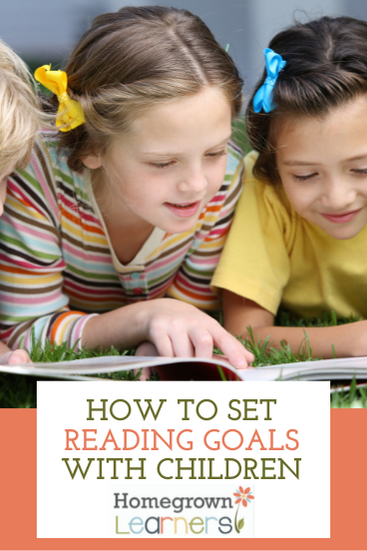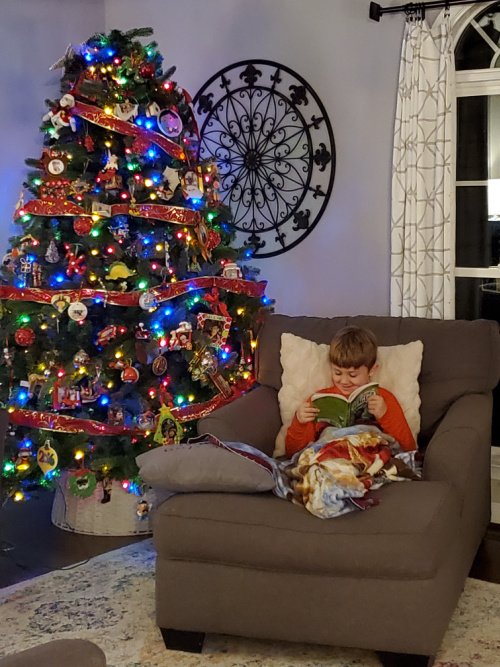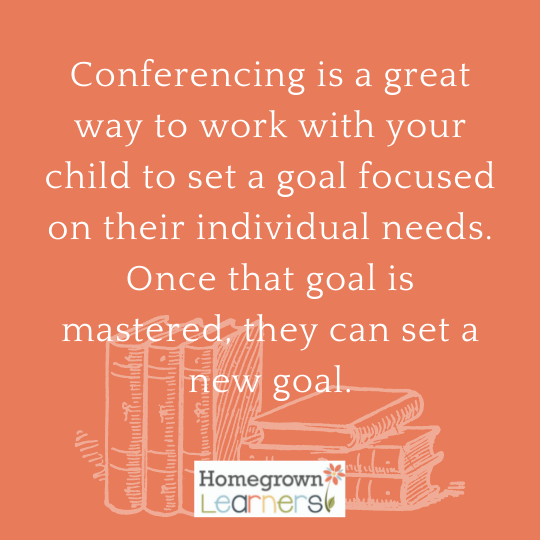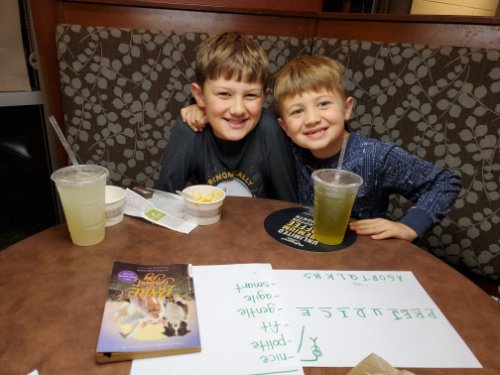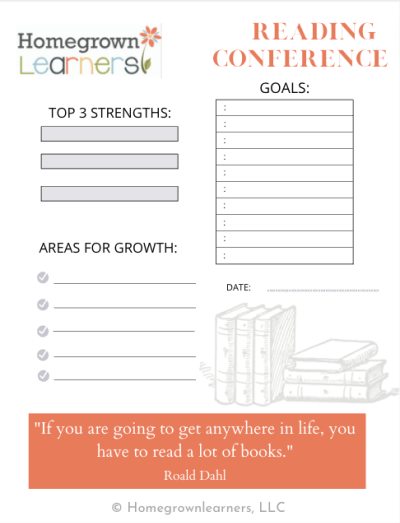Do you set reading goals for your homeschool? Or individual reading goals for your children?
With the New Year approaching it has me contemplating ways I can use goal-setting to help us be more productive in this next phase of our school year.
Typically, over the holidays I take some time to ask myself what is going well with our schooling? Could our schedule use tweaking? Is there a new routine or concept that would be helpful to introduce? What units or studies do I want to make sure to get in?
These next few weeks I am still going to ask myself those questions to see where we need to go from here, but I also want to try setting a few goals for our learning. More specifically, I want to focus on personal reading goals.
Let me encourage you: I am not a natural planner or someone that sets official goals.
Actually, “flying by the seat of my pants” is a more accurate description of my planning skills, but that doesn’t mean to say that I do not plan or do not have goals. Quite the opposite.
Reading feels more complex and open-ended to me than other subjects like math, history, and science, so setting specific, measurable goals is beneficial to help streamline my objectives.
We are anywhere from 20% to 46% more likely to accomplish a goal if we write it down. Our chances get even better if we tell someone else about it, especially if those “someones” are our children! (That last part was not a statistic, that is just what I have found in my experience.) I don’t know about your children, but mine are excellent at holding me (and their siblings) accountable.
Setting Goals to Encourage Reading More Books
Initially, when I was planning our first goal-making session, my focus was on encouraging my boys to read more books. I have written a post in the past about how keeping a list of the books my boys complete has motivated them to read more. That one simple thing jump-started my oldest son’s reading life and it is still going strong.
My middle son was excited about his growing list at first, but after a while his enthusiasm wore off. I decided to try a different approach by sitting down with each of my kids one on one and talking about their reading habits. Next, I worked with them to set a measurable goal that we could track over a month. We decided to set a goal for a certain number of books that they thought they could read in that month.
I was prepared to rein them in if they went off the rails and tried to set a ridiculously high or unchallenging low number. Remarkably they set very reasonable goals and I was sure to let them know I was going to be monitoring how much effort they put into reaching their goal.
This first goal was a learning experience for me - and it probably will be for you, too!
All three of my boys were very successful in reaching their goals. They were all motivated to read more in their free time and they all increased the number of books that they would typically read in a month.
This was an especially good goal for my middle son because he had not previously been reading very often on his own. He also had a perpetually bad habit of starting a book, reading a couple of chapters, and then putting it down never picking it up again. This particular goal really motivated him to finish the books that he starts. He now makes sure that he has a book with him whenever we leave the house, and I have caught him so many times happily reading for fun. Mission accomplished.
My older son was already an avid reader so of course, he blew his goal out of the water. Looking back though, this was not the most productive goal for him because he is already reading a lot of books. My youngest son is a beginning reader, and while he did read more often than he usually would have, at this early stage, there are goals that would have been more beneficial to him.
Setting Individual Goals Through Reading Conferencing
This is a technique from my public school teaching days.
Meet with each of your children and ask them:
What are your struggles with reading?
What do you enjoy about reading?
What is something that you do well/something that you need to work on as a reader?
To finish the conference, I would pick one thing that I wanted them to work on in their reading and leave them with a compliment of something that I noticed them doing well.
In theory, conferencing is a powerful teaching tool. Until you have 20+ students. Then it becomes very difficult to manage and to keep it effective. However, as a homeschooling parent, conferencing is a great way to work with your child to set a goal focused on their individual needs. Once that goal is mastered, they can set a new goal.
Homeschool for the WIN!
Possible Reading Goals
Read a book by a new-to-you author
Read a book from a new genre
Start and finish books that I choose
Go back and reread when what I’m reading doesn’t make sense
Take a 2 second stop when I get to a period
Explore a book of poetry and find 2 poems that you enjoy
Read a book related to (current history or science topic)
I’m willing to bet you naturally do this when you are teaching your children to read. This method is a great way to be a little more strategic by identifying a needed goal, discussing it, writing it down, and putting it into action.
Book Discussion Goals
After setting that first monthly goal all three of my boys have been flying through so many books! I am proud to see their growing lists, but it also left me reevaluating.
Is increasing the number of books they read the most important goal?
Books are the ultimate teaching tool. For a while now I have used the studies from Progeny Press and Brave Writer to use quality literature to teach vocabulary, literary and writing techniques, and character analysis. I make a point to find books related to the history, science, and math topics that we are learning so that they can make those literature connections.
I was content with our course of study, and I felt like we were checking all the boxes of a well-rounded reading education.
Then I read Deconstructing Penguins: Parents, Kids, and the Bond of Reading, and I was blown away. It was written by a husband and wife that started family book clubs with their 2nd-grade daughter, several of her peers, and their families.
Through strategically chosen books, the Goldstones led these families through discussions that taught, not only literary concepts, but many social themes such as moral courage, facing your problems, and the value of learning.
Beyond that, they used multiple titles where the author skewed data to present a biased or even inaccurate point of view. They taught the kids to question what they read, do their own research, and not always assume that everything that an author presents is fact.
What a lesson for the ages!
I was so inspired. The families enjoyed these discussion groups so much that they continued them until their daughter was well into middle school.
Can you imagine those conversations and the relationships that were fostered?
Teaching our children to move past passive reading to dig deep into a book, decipher the meaning behind the author’s words, push past inaccuracies, and have meaningful conversations about what they have read, now THAT is my ultimate goal.
Maybe one day we will start a discussion group with other families but for now, I decided to start on a much smaller scale. We began with Babe: The Gallant Pig and I had my older two sons read a chapter a day to me. After they both finished the book, we had a dinner date with just the three of us to discuss.
Let me be honest. It did not go exactly how I pictured it in my head. (How many times has this happened in YOUR homeschool?)
They were not thrilled to be doing “schoolwork” even though the only work being done was thinking and talking. They got off topic often, had silly moments, but overall, they contributed intelligently to our conversation and (I hope) learned the deeper meaning underneath the story. We found clues about the setting and discussed some of the character relationships. We defined “prejudice” and talked about examples from the book and how it can reflect situations in our own lives.
I’m hoping that the more we have these book discussion dates, that it will become second nature for them to analyze and discuss what they are reading.
Quality books are such a great way to introduce tough topics, teach us to be thinkers, and to open up the line of communication between parents and children. My hope is that over time my boys will start to look forward to and value our discussions.
Right now, my goal is for us to have a Book Discussion Date every other month. That might be too ambitious and it’s important to keep in mind that goals can always be adjusted.
I want my boys to understand that the effort put into reaching the goal and the learning that takes place while working towards the goal is far more valuable than the goal itself.
I know this has been a lot of information but I would like to issue you one piece of advice I heard at a women’s conference a few years ago:
You will get overwhelmed, and you will fail. Pick ONE small thing that you want to work on and do that ONE thing enough until you do it well.
And, this is really applicable to ANY aspect of our lives and homeschools, right?
This is hard for me because I have all the ideas and I want to do all the things and I want them to all be done well… and right NOW. Unfortunately, that is not how we will see success, and doing too much will push our children away from reading. I think choosing one reading goal and putting our focus on that one thing will give us so much more success and we will begin to see real growth in our children’s reading lives.
I hope you enjoy this reading conferencing sheet - download it here for free and I hope it helps your readers set and achieve their goals!
This post is from our contributing writer, Kristen. She is a former teacher with a passion for books, history, and her boys!
I’d love to hear about reading in your home. Do you set goals with your children?
Leave me a comment below!
You might also like:
Favorite Literature Studies for Young Children
7 Steps to Create a Reading Culture in Your Family

